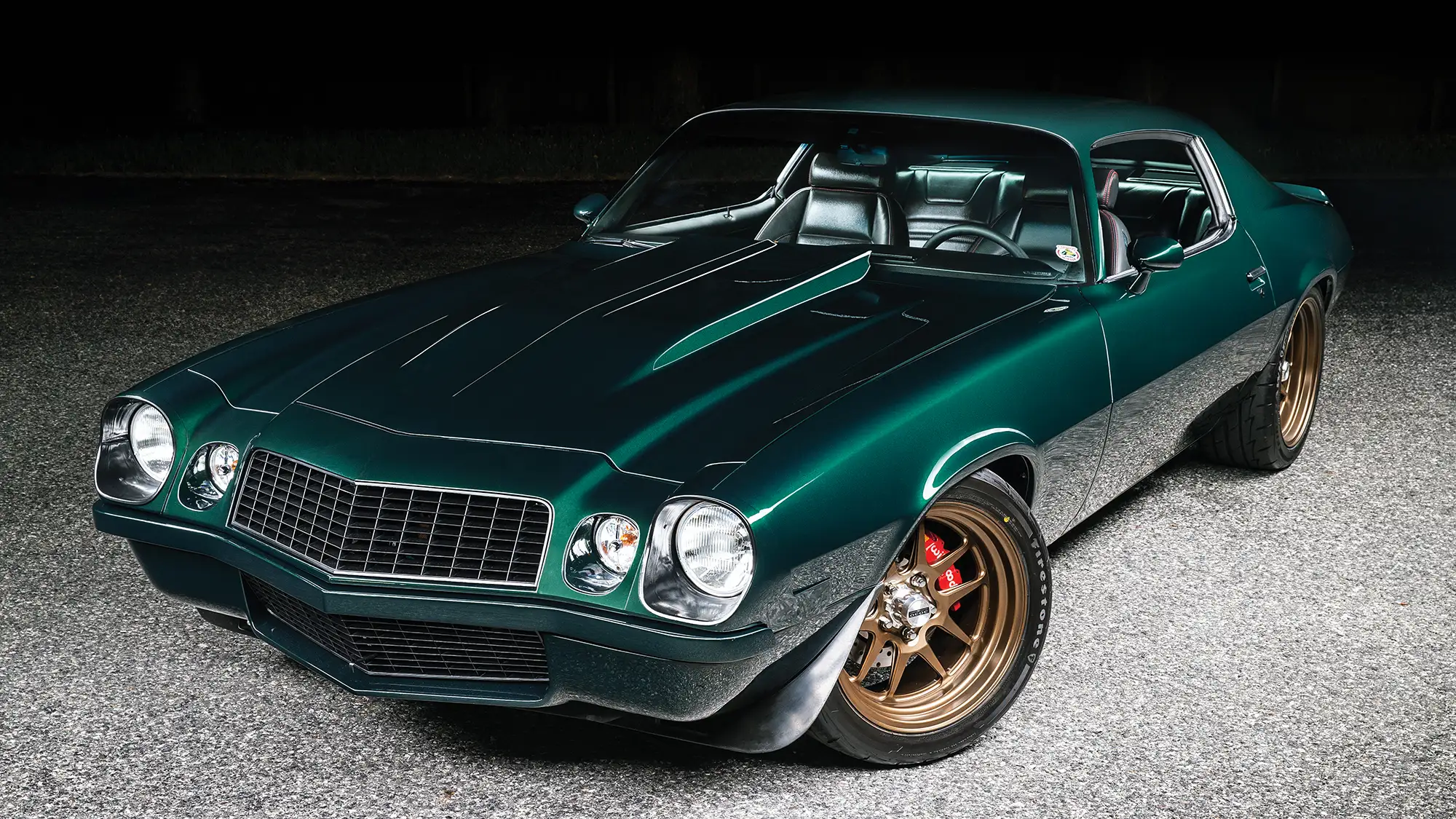
 Images by THE AUTHOR
Images by THE AUTHORost of us have heard the saying about the apple not falling far from the tree. That holds true for many even if the tree is filled with different fruit. In Paul Rivard’s case his affinity for all things mechanical had its origins in the trucking world. Growing up in Massachusetts and then migrating north to New Hampshire in his early twenties, his mechanical influences were directly tied to his family’s trucking company and their truck repair business. He’s not quite sure what sparked that initial interest in all things Chevy, but he does point out that “my first car was a 1967 Mustang. I was 14 years old at the time. By the time I turned 18 I already had a 1971 split bumper Camaro and a Nova as a winter beater.” Family influences weren’t specific, but it didn’t take him long to develop a taste for the way GM products did their thing. He explains, “Chevrolets just came easier to me. Buying them and then getting used to things like how the suspensions were designed on different GM cars and understanding those subtleties was just easier for me to latch onto.” That interest in those suspension nuances set the stage for some of the builds he would execute and is evident in the 1974 Camaro that he recently finished.

Going in, he had a few defined goals on what he wanted to accomplish with the car. Having built a Pro Touring–flavored Nova a few years before, much of what he had learned was programmed into the Camaro in terms of suspension and propulsion, however the redesign of the bumpers and their integration with the rest of the body took him into uncharted waters. All the fabrication activity was set to take place at home in his garage, so any design changes would be born and performed there. He recalls, “Did I have the whole plan in my head? No. The bumper thing came up because I wanted to do something different. I like the 1970 to 1973, and my first inclination was to use those bumpers. I got a set and tried to integrate them, but it just didn’t work. That was when I went off the rails and convinced myself that I was going to make them. The bumper procedure for me was the most difficult to pull off.” Their fabrication was only one part of a larger puzzle because it also meant the design and construction of a modified lower front pan, and a completely new rear splash pan, which was nonexistent on a 1974 Camaro. Part of the lower valance up front involved using an inverted top grille as the solution to the lower opening.




Suspension at all four corners is straight out of the Ridetech catalog, and stopping is accomplished with Wilwood hardware. Rolling stock had to cover both the visual and functional spectrum, so Paul opted for a set of 3030 Autosport G05Y wheels measuring 9.5×18 front and rear all wrapped in 275/40R18 Firestone Firehawk Indy 500 radials.

Roughly 90 percent of the car had taken shape when Paul’s life took a shift westward to the state of Ohio. After the relocation and the settling in process was completed, he went looking for some automotive familiarly, which came in the form of the Northeast Ohio Camaro Club. With just 10 percent to wrap up and his frequent mention that he owned a 1974, his outings to club meets were always met with, “When are we going to see it?” After it broke cover, that changed to “You didn’t say you had one like this.”
The move to Ohio has also opened his weather window, which fits nicely with his plans. He states, “I’m dying to get some miles on it and see how it handles. I want to do some autocross with it and maybe get it out on a road course to see what it can do.” When it comes to regrets, not installing an IRS makes the list—everything else is spot-on.


Vehicle: 1974 Chevy Camaro
Type: 2015 Chevrolet LS3
Displacement: 427 ci
Compression Ratio: 11.0:1
Bore: 4.065 inches
Stroke: 4.100 inches
Cylinder Heads: Chevrolet LS3 aluminum
Rotating Assembly: Callies crankshaft, Callies forged connecting rods, Mahle forged aluminum pistons
Valvetrain: Stock valves, Comp Cams springs, Stock rockers with Comp Cams trunnion kit
Camshaft: Golen Engines custom grind
Induction: Holley LS single-plane intake, Holley Terminator Stealth EFI, Holley HP ECU
Assembly: Golen Engine Service (Hudson, NH)
Exhaust: Hooker Blackheart headers, Pypes 3.0-inch exhaust, Pypes Race Pro mufflers
Ancillaries: Motion Raceworks valve cover baffles, Lokar Classic LS big-block valve covers, Summit 14-inch air cleaner, Cold Case aluminum radiator, Holley mid-mount belt drive system, Cold Case electric fan, Holley Sniper fuel injection tank 400-LPH 18-gallon tank, Holley alternator, Holley water pump, Ringbrothers hood hinges, GM coils
Output: 610 hp at 6,100 rpm, 574 lb-ft at 5,000 rpm
Gearbox: TREMEC T56 Magnum, McLeod RXT twin-disc clutch, McLeod flywheel, TREMEC shifter, Driveline Components clutch master and slave cylinder
Driveshaft: Action Machine driveshaft with 3.5-inch aluminum front face pinion yoke, 1350 U-joints front and rear
Rear Axle: Moser 12-bolt rear, 3.55:1 gears, Moser 30-spline axles, Auburn limited slip
Front Suspension: Ridetech upper and lower control arms, Ridetech TruTurn spindles, Ridetech coilover shocks, Pro Touring F-body 1LE sway bar, Borgeson variable 12.7:1 ratio steering box
Brakes: Wilwood 12-inch rotors front and rear, Wilwood six-piston calipers front, four-piston calipers rear, Wilwood Tuff Stuff 9-inch dual diaphragm master cylinder
Wheels: 3030 Autosport G05Y; 18×9.5 front, 18×9.5 rear
Tires: Firestone Firehawk Indy 500; 275/40R18 front, 275/40R18 rear
Upholstery: Stock Interiors plush cut pile carpet, vinyl/suede with red stitching
Door Panels and Center Console: TMI door panels, Modern Classics console
Seats: TMI bucket seats, RetroBelt seatbelts
Steering: Stock column, Grant Signature series steering wheel
Dash: Modern Classics fiberglass/vinyl dash, Modern Classics hydro-dipped carbon-fiber dash insert
Instrumentation: Holley 6.86 Pro Dash
HVAC: Vintage Air
Insulation: Lizard Skin
Interior Installation: Ace Upholstery (Salem, NH)
Wiring: American Autowire
Entertainment System: Alpine head unit, JL Audio five-channel amp, 10-inch JL Audio subwoofer, and Kicker, and RetroSound components
Hood: AMD 2-inch cowl induction steel
Sheetmetal: Custom front and rear valances, custom rear tail panel
Sheetmetal Installation: Paul Rivard
Bumpers: Custom made by Paul Rivard
Headlights: Hella halogen
Taillights: Stock with DIGI-TAILS LED panels
Grille: Original Equipment Reproduction (OER)
Glass: Fesler front and rear, stock side glass
Bodywork: Paul Rivard
Paint: RM basecoat/clearcoat 2015 Chevrolet Emerald Green
Paintwork: Mike Beaulieu, Mike’s Autobody (Merrimack, NH)